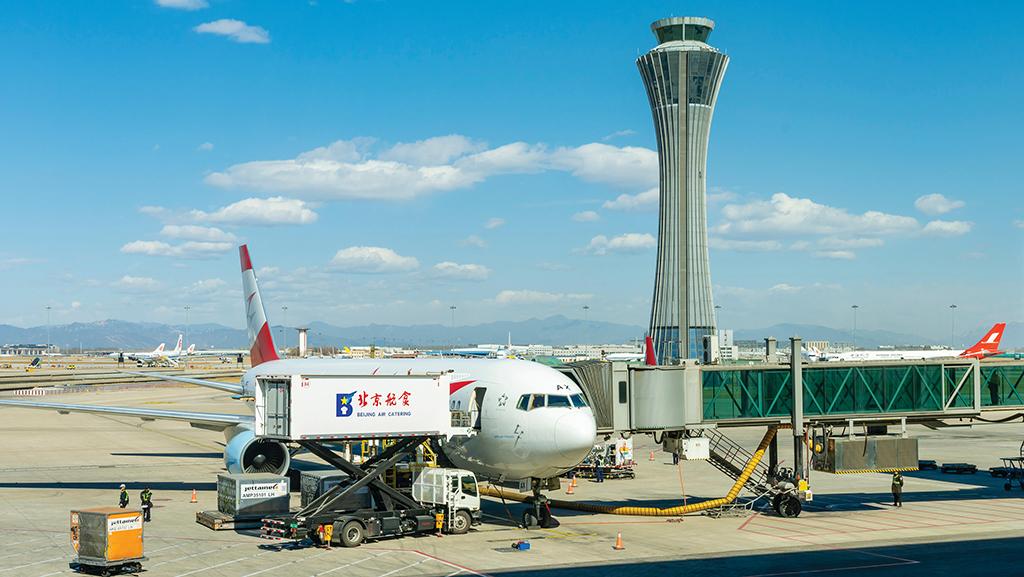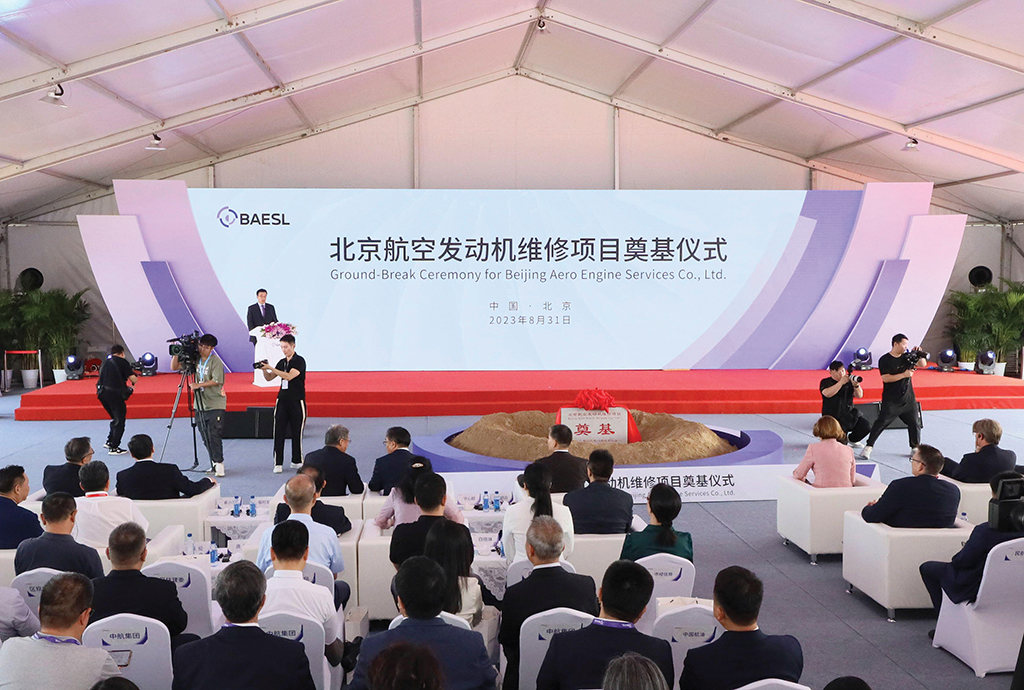
MRO options for carriers at Beijing Capitol Airport will likely increase with several maintenance joint ventures developing in China.
China’s MRO market is set to grow at a compound annual growth rate of 1.13% over the next decade compared with 2.4% for the global average, according to the Aviation Week Network’s Commercial Fleet & MRO Forecast data.
While China is expected to remain among the world’s top five MRO markets, other emerging economies are projected to expand at a much brisker clip. MRO in India is starting from a lower baseline than China, but it nonetheless is forecast to more than double in size in percentage terms—to over $7.9 billion in the decade to 2033 from $3.6 billion now—while China will only grow 12% during that period. For its part, MRO in the Middle East is forecast to grow about 67%, to $18.7 billion from $11.2 billion.
Should the Middle East grow as quickly as predicted, it will overtake China in 2030, becoming the world’s fourth-largest MRO market as China falls to fifth place (see page MRO7). Latin America’s aftermarket is also likely to grow faster than China’s, expanding 33% to $7.7 billion in 2033 from $5.8 billion in 2024.
China’s MRO slowdown dovetails with a broader trend occurring across the country’s commercial aviation sector as geopolitical tensions increasingly affect investment decisions of foreign companies in the world’s second-largest economy. While European and Asian companies remain largely bullish on China’s aftermarket potential, many of their U.S. counterparts are quietly recalibrating business plans in which China once had pride of place.
“U.S. airlines are near-shoring some of their maintenance where the labor costs are comparable or lower and you don’t have to fly so far away,” Joshua Ng, Singapore-based director of the consultancy Alton Aviation, tells Aviation Week. “This began before the geopolitical issues.”
With its proximity, favorable labor costs and close ties to the U.S., Mexico could become a top near-shoring destination for U.S. carriers. Mexico’s National Institute of Statistics and Geography estimates that Mexican factory wages range from $2.75 to $4.82 per hour, compared with $6.50 per hour in China. The institute estimates that Mexican workers on average make $6,900 a year while their Chinese counterparts earn more than $13,000.
Additionally, while [Chinese] “government support is still there” for MRO, “the U.S.-China decoupling . . . affects new investments,” Ng adds.
At this point, “Boeing understands the limitations of what it can do in the China market,” Shukor Yusof, Malaysia-based founder of the consultancy Endau Analytics, tells Aviation Week. “Boeing’s priority is to sell aircraft to China. Before the U.S.-China trade war began, they did that very well. The Chinese love the product.
“Boeing has something in Shanghai similar to a final assembly line, but it’s not at the same magnitude of financing and backing as Airbus has in China,” Yusof notes.
In April, Airbus announced that it would partner with Tarmac Aerosave and the city of Chengdu in Sichuan Province in a joint-venture agreement to establish China’s first aircraft storage, disposal and recycling facility. At 717,000 m2 (7.7 million ft.2) with a storage capacity of 125 aircraft, the facility is being designed to provide aircraft parking and storage, maintenance, upgrades, conversions, dismantling and recycling. The new facility will give Airbus a footprint across the whole aircraft life span in China, from parts manufacturing and aircraft assembly in Tianjin to end-of-life services.
With regard to geopolitical tensions affecting supply chains, “it’s not in Airbus’ interest to see a breakdown in MRO in China,” Yusof says. “European companies are all making sure that this movement of components from Europe to China is continuing to flow.
“Germany is very friendly with China because a lot of German companies have huge businesses in China,” he adds.
For example, Lufthansa Technik has a 25% stake in Ameco Beijing, China’s largest maintenance provider, in which Air China has majority ownership at 75%. Established in 1989, Ameco Beijing is one of the oldest MRO joint ventures in China.
Ameco Beijing signed a decade-long auxiliary power unit (APU) maintenance authorization agreement with Honeywell Aerospace at Aviation Week’s MRO Asia-Pacific conference in September. The agreement grants Ameco Beijing a global authorization license to receive technical and material support from Honeywell when providing APU maintenance services to international and domestic third-party customers on its 331-500 APU.

Credit: Yuen Man Cheung/Alamy Stock Photo
One of the most prominent new MRO investments in China is Beijing Aero Engine Services Ltd. (BAESL), a 50-50 joint venture between Rolls-Royce—its first in mainland China—and Air China. The facility is being built next to Beijing Capital Airport within the Beijing Capital International Airport Economic Zone (September Inside MRO, p. MRO20). BAESL will have a total area of 861,000 ft.2 and enter production starting in 2026. When it reaches full capacity—likely by mid-2030—the facility should support up to 250 shop visits annually, providing MRO services for Rolls-Royce Trent 700, Trent XWB-84 and Trent 1000 engines.
Ni Jiliang, senior vice president of Air China and chairman of BAESL, said the joint venture would further improve Air China’s capability in high-thrust engine maintenance, strengthen MRO industry competitiveness and “build a comprehensive MRO platform of scale.”
Rob Watson, Rolls-Royce president of civil aerospace, said breaking ground on BAESL is an important milestone for “this strategically important joint venture” in the company’s third-largest single-country market, which is also a key part of its supply chain.
“Every major engine shop has one in China to sell to China. You need something in China,” says Alton Aviation’s Ng. “China has been a very good customer of Rolls Royce for a number of years.”
Rolls and Air China arranged the facility’s groundbreaking ceremony to coincide with the visit of UK Foreign Secretary James Cleverly to China, the first such visit by London’s top diplomat in five years.
In an Aug. 31 commentary, the Chinese Communist Party newspaper Global Times described the joint venture as the “latest example of strong business cooperation between the two countries.” Chinese experts cited by the Global Times said the ceremony “is a representation of bilateral cooperation potential in the manufacturing sector, with more cooperation potential to be tackled following Cleverly’s ongoing visit.”
The fact that Rolls has teamed with Air China on this joint venture despite deep concerns in the foreign business community about China’s business environment “in a sense shows that the Europeans are beginning to find that their interests diverge from the Americans,” Yusof says.
Singapore also maintains confidence in China’s MRO market. For instance, in May, Singapore Technologies Engineering (ST Engineering) announced it had incorporated a new joint venture at Hubei Province’s Ezhou Huahu Airport together with China’s Shenzhen Airlines (SF Airlines). The joint venture, in which ST Engineering holds a 60% stake and SF Airlines 40%, has registered capital of $13.7 million. It plans to operate a greenfield airframe facility to serve cargo and passenger airlines operating in the region. The first hangar facility is expected to be ready in 2025.
“A presence in Hubei, China, will enhance our MRO network in Asia to better meet and capture the rising regional demand, while our strategic collaboration with an airline partner will enable us to start up a greenfield operation quickly,” said Jeffrey Lam, president of commercial aerospace at ST Engineering.
In September, Singapore’s SIA Engineering (SIAEC) and Xiamen Iport Group, which owns and operates airports in the Fujian province cities of Xiamen, Fuzhou, Wuyishan and Longyan, signed a memorandum of understanding.
“SIAEC has not been shy [about] expanding outside of Singapore, and they have many different overseas ventures in Southeast Asia,” Ng says. “This [memorandum of understanding] is just the start . . . to hav[ing] a deeper presence in the Chinese market.”
Looking ahead, in addition to geopolitical tensions and concerns about labor costs, China’s unfavorable demographic trend could weigh heavily on the MRO market. The Washington-based Brookings Institution estimates that China’s working-age population peaked at 900 million in 2011 and will decline by about 25% to roughly 700 million by 2050.
“Demographics are really going to reshape Chinese MRO. If you don’t have ready access to cheap labor, you need to think differently,” Jonas Murby, a principal at consultancy AeroDynamic Advisory, tells Aviation Week.
In contrast, India’s working-age population is forecast to continue growing until 2036, when it it is expected to reach 988.6 million, according to the subcontinent’s Ministry of Statistics and Program Implementation.
Both Airbus and Boeing have been pursuing MRO opportunities in India, and Boeing is keen to present itself as helping the subcontinent fulfill its ambitions to emerge as a regional aftermarket hub. Noting its partnerships with India’s AI Engineering Services Ltd., Horizon Aerospace and Air Works Group, Boeing said in October 2022 that MRO localization “to support Indian customers promptly and efficiently remains a top priority for the company.”
The fact that the U.S. and India have a budding defense partnership offers MRO opportunities to Boeing in India that it never could have in China, given the deep-seated great-power competition between Washington and Beijing. Boeing highlights its India supply chain of more than 300 local companies and a joint venture to manufacture fuselages for Apache helicopters. Boeing’s annual sourcing from India is valued at $1 billion.
“Our planned strategic collaboration with indigenous companies under the [Boeing India Repair Development and Sustainment] hub program enables us to provide significant value-add to our customers locally by enabling faster turnaround, exceptional operational capability and mission readiness for the Indian armed forces,” said Surendra Ahuja, managing director of Boeing Defense India.
Alton Aviation’s Ng compares the state of India’s aviation sector to China’s 20 years ago. While acknowledging that India faces certain challenges to growing the industry, notably in infrastructure, he says that “this time around, if the right policies continue to be put in place that develop the MRO ecosystem,” India’s efforts will come to fruition.
